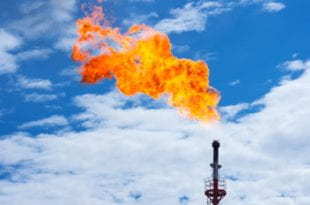Jeff Falk
713-348-6775
jfalk@rice.edu
Reducing gas flaring will benefit economy and environment, says Baker Institute expert
HOUSTON — (Nov. 21, 2019) – Reducing gas flaring throughout the United States would provide substantial economic and environmental benefits, according to a new issue brief by an expert in the Center for Energy Studies at Rice University’s Baker Institute for Public Policy.
“Reducing Oilfield Methane Emissions Can Create New US Gas Export Opportunities” is authored by Gabriel Collins, the Baker Botts Fellow in Energy and Environmental Regulatory Affairs at the Baker Institute.
“Flaring and venting of gas in West Texas’s Permian Basin — and certain other parts of the U.S. — have reached sufficient scale that taken in aggregate, the argument of ‘burning gas to allow oil extraction’ increasingly looks like ‘wasting one resource to produce another,'” Collins wrote. “Regulators in Texas — the flaring capital of the U.S. — have thus far proven highly deferential to industry on the issue of flared and vented gas, even allowing producers to flare when they are connected to a functional pipeline gathering system.”
The amount of gas that analysts estimate was flared in the Permian Basin during the third quarter of 2019, if multiplied by four, could yield as much as 4.8 million metric tons of exportable liquefied natural gas (LNG) on an annual basis if captured and liquefied, Collins said. That volume would exceed the nameplate capacity of a world-class LNG train such as what Cheniere Energy has built at its Sabine Pass facility, he said.
“Flaring is a lost opportunity with compounding economic and environmental costs as well,” Collins wrote. “Burning gas to heat a home, power an industrial process or generate electricity all emit CO2, but they also create value. But when gas is flared, CO2 and other combustion products are emitted, and no value is created. If unburned gas is vented, the environmental impacts are even worse since methane creates much stronger greenhouse effects than CO2 does. And in either case, the venting or flaring means that society lost an opportunity to supplant coal with cleaner, lower-emission natural gas.”
At current flaring and venting rates, if all wasted gas in the Permian Basin was captured and liquefied, it could fill a Q-Max LNG carrier (the world’s largest carrier size) every 10 days, Collins said. If that vessel went to China and discharged its cargo into a power plant, it could likely displace approximately 440,000 metric tons of coal burned to generate electricity.
Over the course of a year, nearly 18 million metric tons of coal could be displaced using the wasted gas of just one U.S. oil and gas play, Collins said. “Even if U.S. gas did not go directly to China due to barriers erected during the ongoing Sino-American trade war, its presence in the marketplace would free up LNG molecules from other exporters that could then flow to China,” Collins wrote. “Data from the World Bank suggests that in 2018, petroleum operations across the entire U.S. flared an estimated 14.1 billion cubic meters of gas — equivalent to 8.7 million metric tons per year of LNG. In energy terms, this is equivalent to more than one-third of the total LNG volume that U.S. firms actually exported that year.”
“‘Being green while making green’ is a winning combination,” Collins wrote. “Actions that improve environmental well-being are most effective and sustainable when they yield a bona fide economic benefit. This certainly would be the case with policies to reduce flaring and venting of natural gas in the US, as doing so would free up gas molecules for export to customers worldwide seeking cleaner, more secure gas supplies. Reducing flaring also helps reduce emissions of carbon dioxide, fine particulates and other potentially harmful substances. The U.S. has both an opportunity — especially in the Permian Basin — as well as the scale (nearly one-fourth of global natural gas production) to make a global difference by addressing local flaring and venting problems.”
Collins conducts a range of globally focused commodity market, energy, water and environmental research. In addition to his research on shifts in China’s domestic oil consumption structure, he focuses on oil field water issues, evolutions in the global gasoline market, water governance and groundwater valuation in Texas and the nexus between food, water and energy.
To schedule an interview with Collins, contact Jeff Falk, director of national media relations at Rice, at jfalk@rice.edu or 713-348-6775. The Baker Institute has a radio and television studio available.
-30-
Related materials:
Issue brief: www.bakerinstitute.org/media/files/files/9553353d/bi-brief-111919-ces-methane.pdf
Collins bio: www.bakerinstitute.org/experts/gabe-collins
Follow the Baker Institute via Twitter @BakerInstitute.
Follow the Baker Institute’s Center for Energy Studies via Twitter @CES_Baker_Inst.
Follow Rice News and Media Relations via Twitter @RiceUNews.
Founded in 1993, Rice University’s Baker Institute ranks among the top three university-affiliated think tanks in the world. As a premier nonpartisan think tank, the institute conducts research on domestic and foreign policy issues with the goal of bridging the gap between the theory and practice of public policy. The institute’s strong track record of achievement reflects the work of its endowed fellows, Rice University faculty scholars and staff, coupled with its outreach to the Rice student body through fellow-taught classes — including a public policy course — and student leadership and internship programs. Learn more about the institute at www.bakerinstitute.org or on the institute’s blog, http://blog.bakerinstitute.org.


